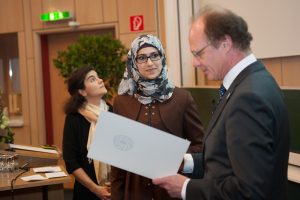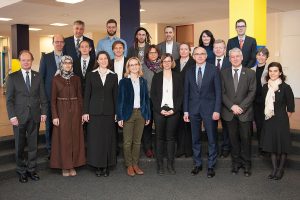

According to Clarivate Analytics, the deputy director of HIU is still one of the world’s most influential researchers in 2017: his work belongs to the first one percent of the most cited papers in his field of research. This applies in particular to the frequency of citations within the year of publication.
Already last year, Thomson Reuters included Prof. Passerini into the list of ” World´s most influential scientific minds of 2015″.
http://www.hiu-batteries.de/battery-research-center-in-germany/news/spalte-1/news/hiu-deputy-director-named-among-world-s-most-influential-scientists/
Clarivate Analytics originally belonged to the media group Thomson Reuters, but was spun off in 2016. Since then it acts as an independent company, whose services are to be found in the area of analyses. Inter alia, the online database Web of Science is part of to the company.
A research team led by Dr. Alberto Varzi and Prof. Dr. Stefano Passerini strengthens, with his recently published research
(http://onlinelibrary.wiley.com/doi/10.1002/aenm.201870001/full), the importance of Zinc as an alternative anode material.
Zinc is becoming increasingly important for battery research. The reasons for this are its large natural abundance and, especially, its potentially larger volumetric energy density compared to graphite. So far though, no satisfactory cycling performance could be achieved with pure Zn anodes.
In this work, which is the result of a collaboration with an Italian team of scientists led by Dr. Sandro Cattarin (former Alexander von Humboldt research fellow, ICMATE-CNR, Padua), inexpensive and environmentally friendly electrodeposition in aqueous solution is used to synthesize Zn-rich porous Copper-Zinc alloys. These novel anodes enable more than 500 cycles, characterized by exceptional rate capability and increased capacity retention. In addition, they have unusually high lithium storage ability at low temperatures. These results are of great interest for more efficient, safer, as well as faster charging of Li-battery operated vehicles in cold regions.
Last Friday, February 2, Montaha Anjass was officially awarded the Mileva Einstein Marić Prize 2017 by the University of Ulm as part of dies academicus 2018.
It addresses the reconciliation of family and academic career: the University of Ulm honors women who stand out through their scientific work, help to shape the university as a scientific institution and manage their careers with their family responsibilities arrange at the same time.
https://www.uni-ulm.de/misc/gleichstellungsportal/foerderung/preise/mileva-einstein-maric-preis/
After completing her bachelor’s degree at Birzeit University and performing as a teaching assistant, the Palestinian native emigrated to Ulm in 2013. As part of her degree (M. Sc Advanced Materials), she began working at the HIU in 2015 as a research assistant in the Materials I research group.
Meanwhile, she is working in a joint PhD position at the Institute of Inorganic Chemistry, the Institute of Electrochemistry and the HIU.


With the increased significance of lithium-ion batteries, the pressure on the availabiltity of relevant ressources rises. Especially, lithium and cobalt are fundamental components of present lithium-ion batteries. A recent analysis of a research team led by Dr. Daniel Buchholz and Prof. Dr. Stefano Passerini shows that the availability of both elements could become seriously critical. Cobalt-free battery technologies, including post-lithium technologies based on non-critical elements such as so-dium, but also magnesium, zinc, calcium and aluminium, represent possibilities to decrease the dependency and avoid the crit-icality of lithium and Co.
The researchers present these results in the journal Nature Reviews Materials. In addition, the publication will be part of the Nature Reviews Materials online collection Chemistry at the nexus of water and energy, which contains selected articles from the field of natural science.
Further information can be found in the current press release.
The transition to renewable energy challenges battery researchers to develop suitable energy storage technologies. Lithium-ion batteries are currently the most widely used battery technology for various applications, including electric vehicles. For their establishment, however, further improvements are necessary regarding their safety, performance and charging times.
Within a perspective assessment, representatives of the four leading national economies – USA, China, Japan and Germany – Perspectives of automotive battery R&D in China, Germany, Japan, and the USA address these issues, highlight the present state-of-the-art and provide and overview of the current and future developments with a particular focus on the funding programs of these four countries.
The release is the result of the annual International Conference on Advanced Lithium Batteries for Automobile Applications (ABAA), which took place in October last year, and has the aim to foster the exchange between industry and research institutions.
The perspective article is freely available online for anyone to access until 8 December 2018.
On May 2nd, a delegation of 10 members of the Electrochemical Society (ECS) Student Chapter of the Technical University of Munich (TUM) visited Ulm´s ECS Student Chapter, which is the youngest and -after Munich- the second student chapter of the ECS in Germany. Founded at the beginning of this year, the members the Student Chapter Ulm are currently PhD students from different electrochemical research groups, e.g. from the Helmholtz Institute Ulm (HIU), Center for Solar Energy and Hydrogen Research (ZSW) and Ulm University (UU). At the ZSW in Ulm, the lab-tour took the participants via the 10.000 m² ZSW Laboratory for Battery Technologies (eLaB) over to the H2 filling station and to the laboratories for hydrogen analysis, as well as to the fuel cell test center. At the HIU the lab-tour and a presentation displayed the combination of fundamental and applied research. During this meeting, both Student Chapters from Munich and Ulm could not only start networking on shared scientific topics, but they were also able to start planning future events, to improve the interdisciplinary competence of every student, according to the ECS guidelines:
“The mission of an ECS student chapter is to provide students the opportunity to foster a greater understanding as well as promote electrochemical and solid-state science and technology amongst its peers, to further enhance their professional development and to enrich their academic experience.”
Open to all graduate (PhD) students / Postdocs working on electrochemistry in the area of Ulm, the goals of the student chapter is to share and enlarge knowledge, as well as to establish collaborations amongst different research groups in the area of Ulm and the south of Germany. To become a member of the Student Chapter Ulm, you also have to be a member of the Electrochemical Society. ECS membership offers free access to ECS journals and discounts for ECS meetings and publishing fees. For Student Chapter Members, ECS membership is free.
The Karlsruhe Institute of Technology (KIT), the Ulm University (UUlm) and the Centre for Solar Energy and Hydrogen Research Baden-Württemberg (ZSW) strengthen their collaboration in the area of Electrochemical Energy Storage. Founded on Jan 1, 2018, the Center for Electrochemical Energy Storage Ulm-Karlsruhe (CELEST) plans, prepares and organizes new joint endeavors in research, teaching, development and technology transfer. CELEST shall act as a platform to improve communication and to co-ordinate and further develop joint activities with other universities and research institutions as well as the industry, at home and abroad. With 30 institutes, which are active in the field of electrochemical energy storage, CELEST represents the largest research platform for this topic in Germany.
“CELEST is a logical next step in linking the Ulm and Karlsruhe locations more closely. The HIU as a joint institute of the KIT and the University of Ulm with its structure represents a nucleus of this now extended network”, emphasizes Maximilian Fichtner, director of HIU.
The expertise at both sites is complementary and ranges from basic research on the atomic scale to the largest pilot plant for cell production in Germany. The three institutions will co-operate on interdisciplinary research and development ranging from basic research to technical applications and on the qualification of students.
“CELEST places emphasis on Li-Ion technology, Energy Storage Beyond Lithium and Alternative Techniques for Electrochemical Energy Storage and covers all current topics in this field. On the topic Energy storage beyond lithium the platform takes up a national and international top position, says Fichtner.
At the two-day biennial meeting with 120 participants, the researchers presented their research results of the last two years and discussed and decided on the direction for the future. The scientific exchange was tailored to the four HIU interdisciplinary topics – Metal Deposition and Interfaces, Insertion Materials and Electrode Structure, Lithium Based Conversion Materials and Alloys, Batteries Beyond Lithium. In each of the four topics, members of different research groups efficiently pool their competencies in this way.
Maximilian Fichtner and Stefano Passerini, Director and Deputy Director of the HIU, emphasized the numerous new international collaborations concluded in the last two years and the very good publication average with two publications per researcher per year. In addition, the up to now successful application for the federal government’s excellence strategy and the establishment of the battery research platform CELEST make optimistic for future research work.
The Kick-off meeting of CELEST and the first general assembly of its members took place at the HIU, Ulm. The CELEST members elected the spokespersons of the three research areas, actively discussed joint projects and decided on future activities and strategies for the research platform. The CELEST steering committee nominated Prof. Maximilian Fichtner as director of CELEST and Prof. Helmut Ehrenberg as deputy director of the center. The meeting laid a strong foundation for fruitful collaboration and impressively illustrated the broad range of scientific competences gathered among the CELEST members, paving the way for new joint endeavors in electrochemical energy storage.
The article “Aqueous/Non-aqueous Hybrid Electrolyte for Sodium-ion Batteries” is among the most read articles for the past month on the website of the journal ACS Energy Letters.
The team of researchers directed by Stefano Passerini reported an aqueous/nonaqueous hybrid electrolyte based on sodium trifluoromethanesulfonate with an expanded electrochemical window up to 2.8 V and high conductivity (∼25 mS cm–1 at 20 °C). The hybrid electrolyte inherited the safety characteristic of aqueous electrolytes and the electrochemical stability of nonaqueous systems, enabling stable and reversible operation of the Na3V2(PO4)3/NaTi2(PO4)3 sodium-ion battery.